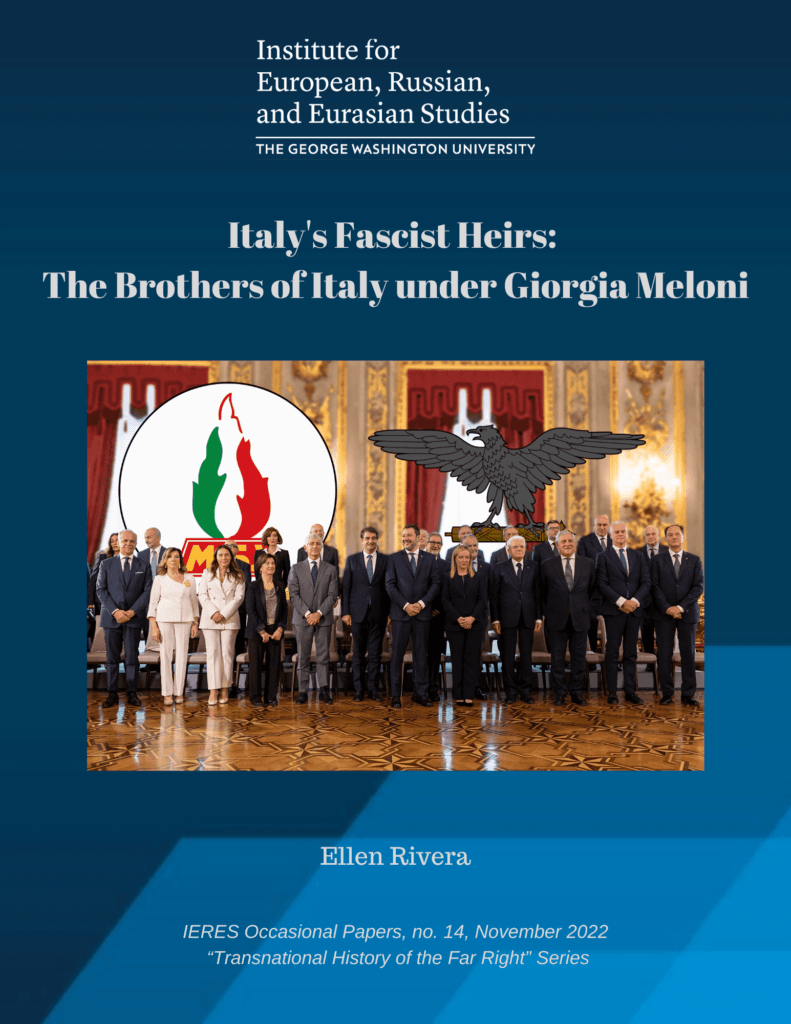
Italy’s Fascist Heirs: The Brothers of Italy under Giorgia Meloni
Ellen Rivera
IERES Occasional Papers, no. 14, November 2022 “Transnational History of the Far Right” Series
Photo Cover by John Chrobak using “Meloni Cabinet (49083)” by Quirinale.it
The contents of articles published are the sole responsibility of the author(s). The Institute for European, Russian, and Eurasian Studies, including its staff and faculty, is not responsible for any inaccurate or incorrect statement expressed in the published papers. Articles do not necessarily represent the views of the Institute for European, Russia, and Eurasian Studies or any members of its projects.
©IERES 2022
The Italian general elections took place on September 25, 2022, and, as anticipated, the far-right Brothers of Italy (Fratelli d’Italia, FdI) became the strongest party in the country, with 26.25% of the vote.[1] Founded in 2012, since 2014 the party has been presided over by Giorgia Meloni, who in October 2022 was confirmed as Italy’s first female prime minister—a woman proudly carrying forward Italy’s fascist heritage.
Fratelli d’Italia pledged to enter a right-wing-to-far-right governing coalition, which had already formed a pre-electoral alliance, the so-called “coalition of the center-right” (La coalizione di centro-destra). The alliance includes the right-wing to far-right Lega (League) party of Matteo Salvini, and Silvio Berlusconi’s right-wing Forza Italia (Forward Italy), which received a little over 8% of the votes apiece; as well as 10 other minority parties, six of which ran under a joint electoral list called Noi Moderati (We, the Moderates).[2] Together, the alliance won about 43% of the national vote, which, due to the country’s parallel voting system, grants it a majority of seats in the Chamber of Deputies (112 of 200) as well as in the Senate (235 of 400).
Although FdI politicians such as Meloni keep on repeating that they are representing a center-right party that poses no threat to democracy, this article seeks to shed light on the neofascist background of the FdI and the danger that its participation in a government coalition poses.[3] As evidenced by personal, structural, ideological, and iconographical continuities, the FdI stands in a lineage that reaches back to the first postwar Italian neofascist party, the Mussolini-inspired Italian Social Movement (Movimento Sociale Italiano, MSI), and even further to the Nazi-affiliated Salò Republic. Furthermore, this article seeks to demonstrate that the current “center-right” coalition, which brings in unapologetic fascists, has its historical precedence in Berlusconi’s previous cabinets—however, this time with a far-right party at the helm.
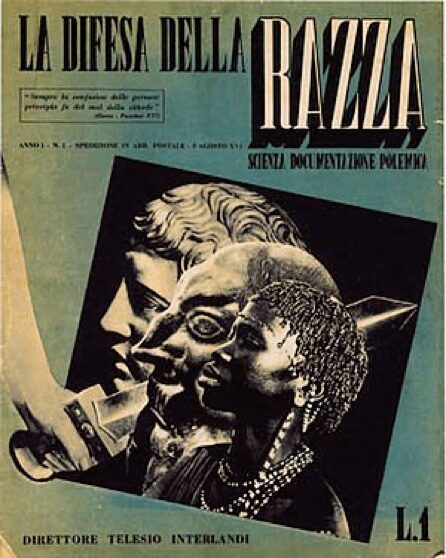
| Cover of the first issue of La Difesa Della Razza.Source: Wikipedia. |
In order to understand the significance and scope of FdI’s neofascist revival, it is
indispensable to recall the origin and history of its predecessors, starting with the Movimento Sociale Italiano, which existed from 1946 to 1995. The MSI was the direct offspring of the Republican Fascist Party (1943–1945), the party at the helm of the Italian Social Republic (Salò Republic), the Nazi puppet state created by Benito Mussolini in 1943 in Northern Italy.
The MSI included various dignitaries of the Salò Republic. It was founded and for the longest period headed (1969–1987) by Giorgio Almirante (1914–1988), a Nazi collaborator, who previously had been involved in the Republican Fascist Party and its predecessor, the National Fascist Party (1921–1943). As editor-in-chief of the antisemitic and racist magazine La Difesa della Razza (the defense of the race, 1938–1943), funded by the Ministry of Popular Culture, Almirante was responsible for the promulgation of the Italian racial laws, kicked off by the publication of the “Manifesto of Race” in 1938, which stripped Italian Jews and and native African inhabitants of the Italian colonies of their citizenship.
The MSI also included Rodolfo Graziani (1882–1955), the former Defense Minister of the Salò Republic, whose brutal conduct as commander of the Italian troops in North Africa earned him the nickname “The Butcher of Fezzan.” Last but not least, until 1967 the “Black Prince” Junio Valerio Borghese (1906–1974) was involved in the party, the infamous Navy commander under Mussolini who in 1970 was involved in the planning of a neofascist coup (Golpe Borghese).
Far from remaining in the shadows of the past, Meloni and the FdI pay active homage to this fascist ancestry. In 1996, in an interview with the French newscast Soir 3, Meloni praised Mussolini as “a good politician, the best in the last 50 years.”[4] As late as in May 2020, she paid tribute to the racist and anti-Semitic Almirante, demonstrating that her fascist apologia has not been a merely youthful sin.[5]
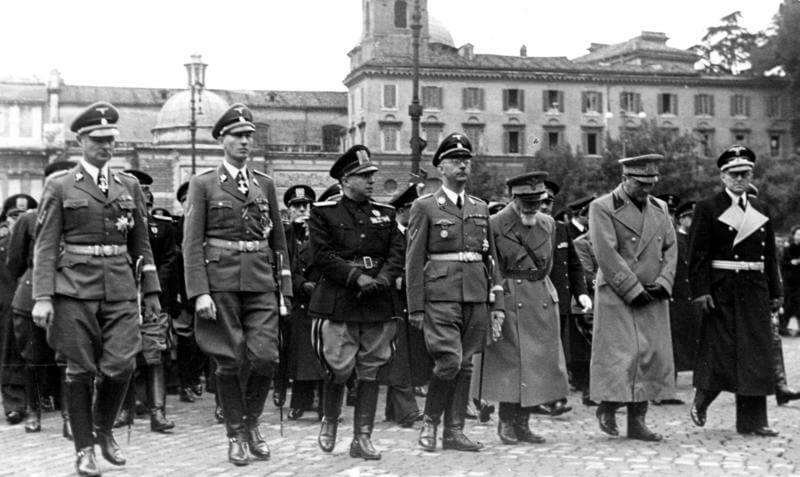
| German and Italian state officials attending the funeral of Rome police chief and prominent Fascist Party member Arturo Bocchini on November 21, 1940. From left to right: Karl Wolff, Reinhard Heydrich, Adelchi Serena, Heinrich Himmler, Emilio De Bono, Rodolfo Graziani, and Hans Georg von Mackensen. Source: Wikipedia. |
The MSI certainly grew in favorable conditions, in a period when the Italian right received considerable support from abroad, particularly from the United States, since it was feared that Italy could turn Communist. One may recall that one of the first projects of the newly-founded CIA was to interfere in the Italian general elections of 1948, which swung them in favor of the right-wing Democrazia Cristiana, and continued to do so into the 1970s.[6] As the 1976 Pike Report revealed, “Intervention in Italian elections from 1948 onwards cost the CIA $75 million.” And as of the early 1970s, the CIA had also funded “political forces of the Italian neo-fascist movement.”[7] The historian Deborah Kisatsky has noted that during the first postwar decade, “U.S. interventionism in Italy included the recruitment and use of authoritarian and even fascist-minded figures in service to American power” and that “American operatives [were persuaded] that Italian nationalism must not merely be contained, but also co-opted, to serve U.S. purposes.”[8]
From the 1950s onwards, the European far right was generally bolstered by the emergence of so-called stay-behind networks throughout the continent, clandestine military formations to be activated in case of a Communist takeover.[9] Established in the 1950s under the auspices of various intelligence services of the Western European Union, NATO and the CIA, stay-behind agents were in many instances recruited from surviving fascist and Nazi networks.[10] The Italian stay-behind network, dubbed Operation Gladio (or simply “Gladio,” for short), which included various MSI members over time, developed a life of its own, whereby certain elements served as street-level militants, some of whom were implicated in violent actions.[11] Besides far-right elements, Italy’s Gladio network included various members of the clandestine Propaganda Due (P2) Masonic lodge, a criminal organization dissolved in 1982, of which Berlusconi was notably a leading member.[12] P2’s venerable master, Licio Gelli (1919–2015), had been a volunteer in the Spanish Civil War, and during the Salò Republic he was a liaison officer between the blackshirts of the Italian Fascist government and Nazi Germany, with connections to Reichsmarschall Hermann Göring.[13] Until its dissolution in 1982, P2 included the highest echelon of Italy’s power brokers from the military, intelligence, aristocracy, politics, finance, industry, and media.
Against this backdrop, the MSI played an integral part in the reconstitution of the European-wide Nazi and fascist networks in the postwar period. As such, in 1950 the party co-hosted two preliminary meetings in Rome that lead to the establishment of the European Social Movement (ESM) in 1951, which comprised several former SS members, as well as key Nazi collaborators and ideologues from across Europe.[14] One of the meetings was organized under the guise of the MSI’s student organization, Fronte universitario d’azione nazionale (FUAN, 1950–1996), which can be considered the forerunner of Fratelli d’Italia’s student organization Azione Universitaria, as the latter still uses the FUAN logotype, only with a different name (see chart below).
The ESM was an important branching point from which even more radical groups emerged, such as New European Order in 1951, which included militant MSI members like Pino Rauti (1926–2012) and the future terrorist Stefano Delle Chiaie (1936–2019).[15] These developments were mirrored in the Italian far right, with the foundation of the Ordine Nuovo (New Order) group within the MSI by Rauti in 1953 under the tutelage of the former SS/SD[16] agent and Nazi ideologue, Julius Evola
(1898–1974), who was also among the initial ideologues of the MSI.[17] As such, Evola provided the first youth charter (“Carta della Gioventù”) to the party in 1951, adopted by the MSI’s initial youth organization, Giovane Italia (young Italy 1954–1971).[18]
Ordine Nuovo, the most noteworthy cradle of postwar militant neofascism in Italy, ultimately split from the MSI in 1956 as Centro Studi Ordine Nuovo (New Order Study Center, 1956–1969) when the party was led by Arturo Michelini (1909–1969), who wanted to steer the MSI towards a more mainstream right-wing direction and establish a pan-right parliamentary alliance of the party with the Christian and monarchist right.[19] It is known that while he was an organizer of the militant Ordine Nuovo, Rauti had been involved in an important Gladio meeting in 1965, and “was literally in the pay of the American embassy in Rome.”[20] After Michelini’s death, with the return of the hardcore fascist Giorgio Almirante to the helm of the MSI, Rauti dissolved the Study Center in 1969 and rejoined the party with a group of Ordine Nuovo leaders. Some of the militants opposed Ordine Nuovo’s return to the MSI, and in December 1969 established the Movimento Politico Ordine Nuovo (New Order Political Movement, official: 1969–1973; underground: 1974–1979), led by Clemente Graziani.
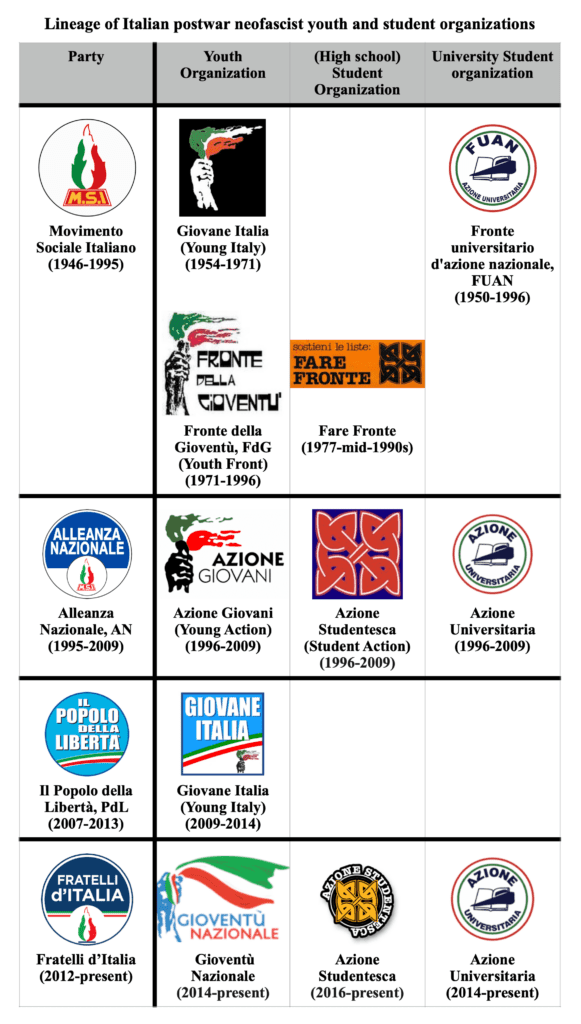
Several members of Ordine Nuovo and its offshoots, alongside militant neofascist groups, such as Avanguardia Nazionale, participated in a series of domestic terrorist attacks, kicked off by the 1969 Piazza Fontana bombing, which caused 17 deaths and 88 injuries.[21] These terror attacks, which entered Italy’s history as the so-called Years of Lead (1968–1981), have frequently been associated with the Gladio orbit. Pino Rauti was also heavily implicated; however, he ultimately managed to elude justice.[22] The entanglements of far-right terrorism with intelligence services are evident in the story of former MSI member-turned-terrorist, Stefano Delle Chiaie, who was deeply involved in several key Years of Lead events; and yet, he too was never convicted for his crimes.[23] Tied to P2, and a friend of Licio Gelli, after the 1969 Piazza Fontana bombing Delle Chiaie operated from the protection of Generalísimo Francisco Franco’s military dictatorship in Spain, and ultimately joined Operation Condor, the US’s brutal interventionist campaign in Latin America in the mid-1970s.[24]
Rauti’s radical influence within the MSI continued throughout the 1970s, and found particular resonance in the party’s youth and student organizations. Under his auspices, ideas of the French New Right were introduced to the MSI’s young cadre, first in the context of so-called Hobbit Camps from 1977 onward.[25] That year the MSI’s youth organization Fronte della Gioventù (youth front) (1971–1996) started to publish a New Right magazine called Fare Fronte,[26] which culminated in the creation of a student group by the same name.[27] In all likelihood, Fare Fronte adopted its logo, a swastika variant of a Celtic cross, from the French New Right think tank Groupement de Recherche et d’Études pour la Civilisation Européenne (GRECE), founded in 1968 by the far-right ideologues Alain de Benoist, Dominique Venner, and others.[28]
It was in the MSI’s Youth Front that, at the tender age of 15, Giorgia Meloni began her political career during a period of profound political upheaval in Italy. Starting in 1990, a series of scandals shook Italy that were kicked off by Prime Minister Giulio Andreotti’s revelations in October of that year
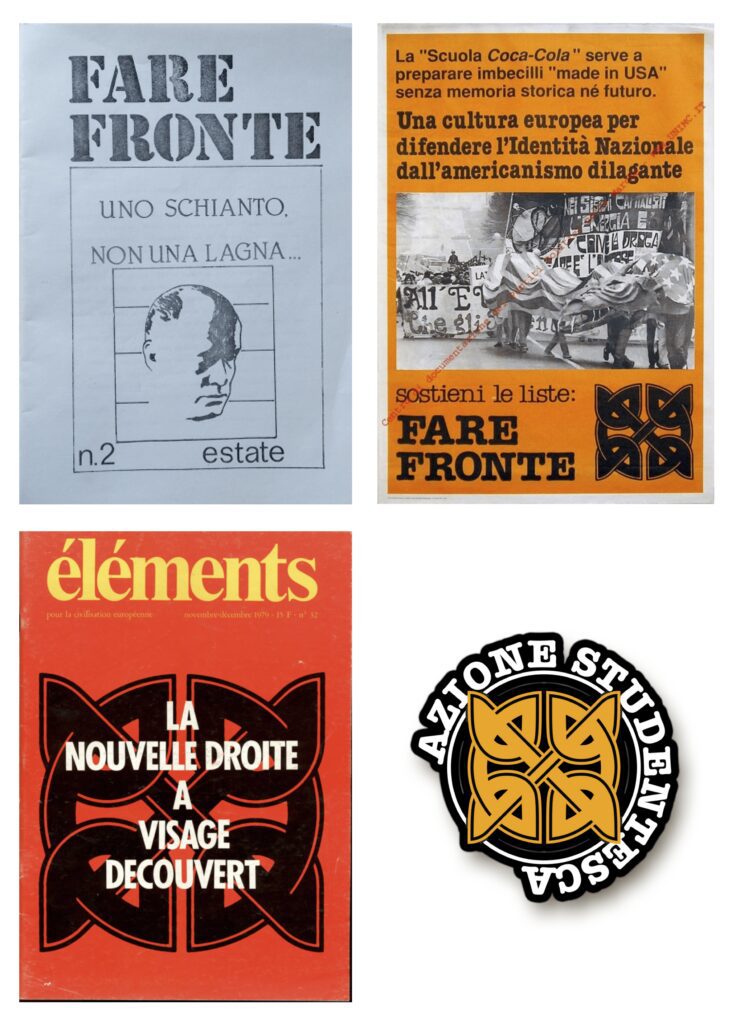
| Top left: Issue 2 of Fare Fronte, published by the MSI youth group Fronte della Gioventù (ca. October 1977).Top right: Fare Fronte poster (undated).Bottom left: Front page of issue 32 (1979) of Éléments, the publication of GRECE.Bottom right: Logo of Azione Studentesca (1996–2009; relaunched 2016). |
about the Gladio network; followed by the Mani Pulite (“clean hands”) scandal in 1992, which unveiled a vast system of political corruption, in which more than half the members of parliament were indicted at some point or other. These scandals led to the dissolution of some of Italy’s longstanding postwar parties, including the MSI (1946–1995), Democrazia Cristiana (1943–1994), the Italian Socialist Party (1944–1994), and a few years later, the Italian Social Democratic Party (1947–1998).
The ripple effects of the turmoil that was brought on by these scandals unsettled the postwar establishment, which had been backed by American support.
Alleanza Nazionale and the First Berlusconi Cabinet
It was none other than Silvio Berlusconi, media mogul and longtime P2 member, who managed to profit from the political shambles, when in 1994 he founded the first iteration of Forza Italia (1994–2009) as launchpad for his political career. In 1994, as prime minister, he came to head a right-wing to far-right coalition, the first Berlusconi government, which included the newly-founded Northern League (the precursor of today’s Lega party of Matteo Salvini), as well as the National Alliance party (Alleanza Nazionale, AN), the legal successor to the dissolved MSI. As late as 2019, Berlusconi took credit for having brought “fascists and the League” into the government.[29] In that, the first Berlusconi government served as a model for the current coalition of the Italian right.
When in 1995 the MSI disbanded, Meloni joined its successor Alleanza Nazionale, which existed from January 1994 onwards as an electoral list, and from January 1995 until 2009 as a party under the leadership of Gianfranco Fini (b. 1952). Fini had been a protégé of longtime MSI leader Giorgio Almirante, who made Fini national secretary of the MSI’s Youth Front in 1977. And Fini took over the MSI leadership from Almirante in 1987.
Alleanza Nazionale showed not only personnel continuities, but it carried over the MSI’s youth and student movement infrastructure, including its division into youth, high school, and university student wings.[30] In 1996, Meloni became head of AN’s high school wing called Azione Studentesca (Student Action, 1996–2009), built on the MSI student group Fare Fronte, and as such adopted the latter’s logo sporting a swastika variant of a Celtic cross.
The MSI’s youth organization Fronte della Gioventù turned into AN’s Azione Giovani (Young Action) (1996–2009), carrying over the former’s logo with a fist holding a tricolor flame. From 2002 to 2004, Meloni became part of Azione Giovani’s leadership committee, and from 2004 to 2009, leader of the youth organization.
From there, Meloni’s political career took off. In 1998, after winning a primary election, she was elected as a councilor for the Province of Rome, a position she held until 2002. In the 2006 general election, she was elected to the Chamber of Deputies, of which she became the youngest-ever vice president.
Her background as a far-right youth leader payed off under the fourth Berlusconi government (2008–2011), when she was made Minister of Youth, becoming United Italy’s youngest-ever minister. Berlusconi’s fourth cabinet was a treacherous alliance of right-wing to neofascist parties,
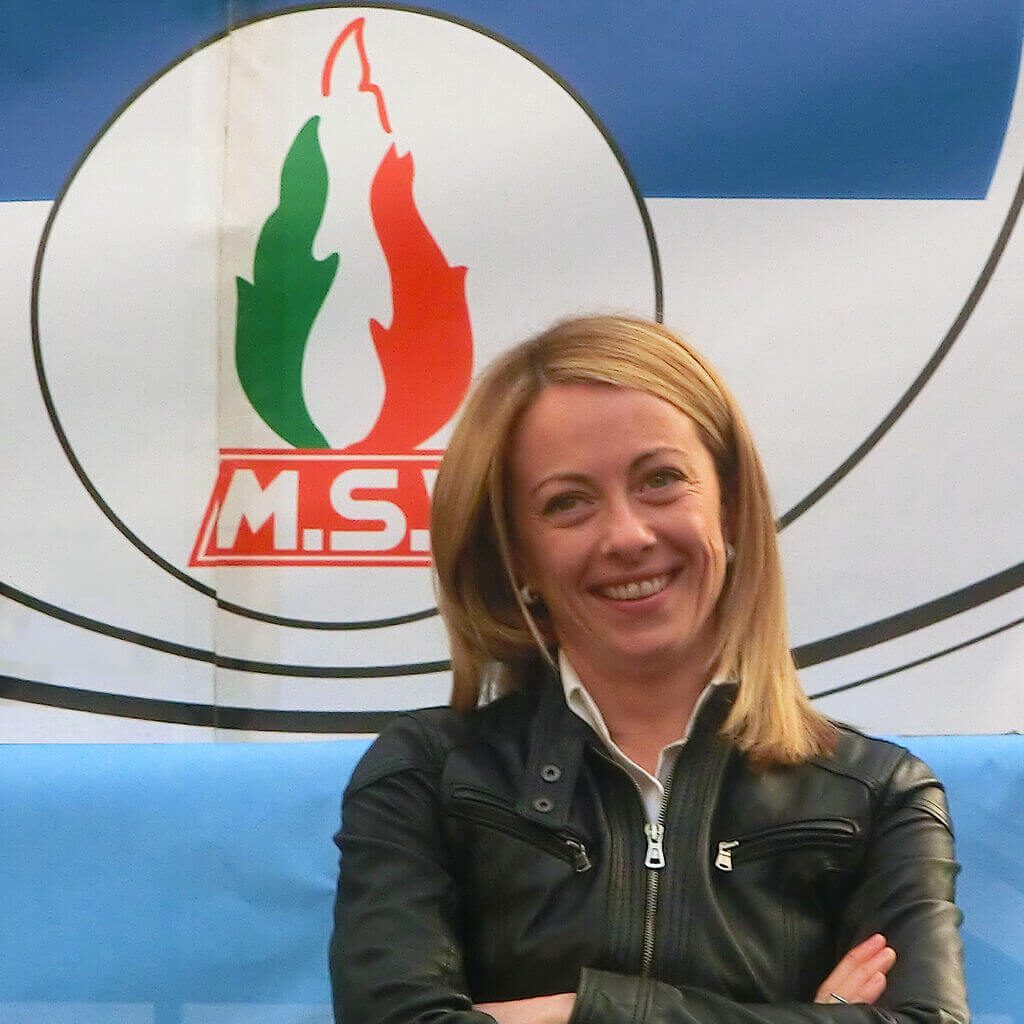
| Giorgia Meloni in Sanremo during the electoral campaign for the 2014 European elections. Source: Wikipedia. |
most of which merged into the big-tent right-wing party, Il Popolo della Libertà (the People of Freedom, PdL), lasting from 2007 to 2013, which Meloni and her party Alleanza Nazionale also joined. Berlusconi abandoned his own party, Forza Italia, to head the new catch-all party, which notably merged Forza Italia; Alleanza Nazionale; and Azione Sociale (Social Action, 2003–2009), a short-lived neofascist party founded by Alessandra Mussolini, the granddaughter of Benito Mussolini.[31] The Berlusconi cabinet was supported by a coalition between PdL and Lega Nord (Northern League), together with other smaller right-wing parties. Meloni took over the presidency of the PdL’s youth wing, Giovane Italia (2009–2014), which carried the name of the MSI’s first youth organization, and, as its precursors within the MSI and Alleanza Nazionale, sported a fist with a tricolor flame in its logo.
The cobbling together of the fourth Berlusconi cabinet did not come about by happenstance. Evidence suggests that the preceding center-left government led by Romano Prodi had been toppled with pressure exerted by the United States. In early 2007, after only nine months in power, Prodi’s government was confronted with several divisive foreign policy issues, including the expansion of the US military base Caserma Ederle near Vicenza, as well as the continued deployment of Italian troops to support the US war in Afghanistan, which pushed Prodi’s fragile coalition towards collapse.[32] Furthermore, a court document recording the questioning of Sergio De Gregorio suggests that the CIA had a vital role in bringing down the Prodi government.[33]
Ultimately, amid financial crisis and public protests, the immense corruption of the Berlusconi government brought about its own downfall, leading also to the dissolution of the short-lived Popolo della Libertà party in 2013, which had been a quarrelsome marriage of convenience from the start.
Fratelli d’Italia
When Fratelli d’Italia (FdI) emerged in 2012 towards the end of Berlusconi’s failing experiment at running a right-wing big-tent party, it built upon on the structures of the previous mainstay neofascist parties: the Movimento Sociale Italiano and its successor, Alleanza Nazionale. FdI proudly advertises these origins in its logo, reusing the tricolor flame which had already been featured in the emblem of the MSI, as well as the blue ribbon of the Alleanza Nazionale logo.
Two of Fratelli d’Italia’s three founders, Giorgia Meloni (b. 1977) and Ignazio La Russa (b. 1947), as well as many other FdI politicians, had been attached to MSI and Alleanza Nazionale in the past, thus maintaining a significant continuity in personnel. As a leading member of FdI, Meloni was elected to the Chamber of Deputies from Lombardy’s third district (2013–2018), but subsequently went on to successfully run as candidate for the Latina district (since 2018). A fascist stronghold south of Rome, the district’s capital of the same name was founded by Mussolini as a model city and is known for its fascist architecture. According to Haaretz, Meloni stated that she “chose to run here because this is a symbolic city that has a very strong connection to the history of the Italian right.”[34]
Veneration for fascists seems to run in Meloni’s family. Her sister Arianna’s husband, Francesco Lollobrigida (b. 1972), who since 2018 has been FdI’s parliamentary group leader in the Chamber of Deputies, inaugurated a monument at Affile dedicated to MSI founder Rodolfo Graziani.[35]
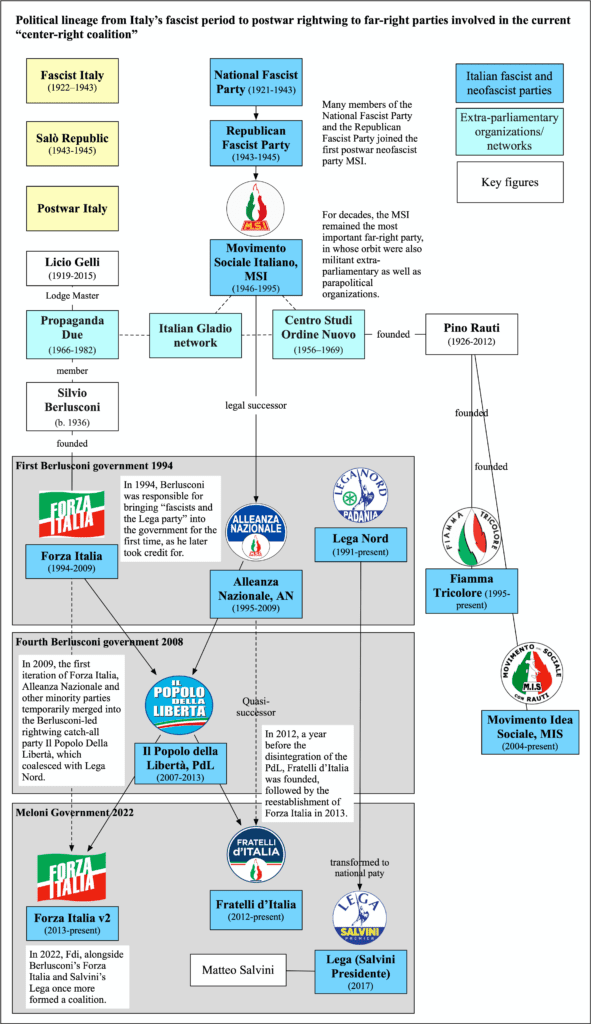
FdI’s co-founder (and currently the President of the Italian Senate), Ignazio La Russa, is also known for his fascist apologia, who reportedly stated that “we are all heirs of the Duce.”[36] La Russa, president of FdI from 2013 to 2014 and a longtime patron of Meloni, has his roots in the neofascist MSI. La Russa followed in the footsteps of his father, Antonino La Russa, who was a former political secretary of the National Fascist Party in Paternò (located in Sicily) in the 1940s, and after World War II became a senator for the MSI. In 1971, Ignazio La Russa was in charge of the MSI’s Fronte della Gioventù (youth front), which Meloni joined about 20 years later. Like Meloni, after the dissolution of the MSI La Russa became affiliated with Alleanza Nazionale, ultimately serving as the party’s acting president (2008–2009) before its merger with Berlusconi’s Popolo della Libertà, which he oversaw. He subsequently served as PdL’s coordinator from 2009 to 2012.
Among Fratelli d’Italia’s candidates are two descendants of the Mussolini family. Rachele Mussolini, Benito Mussolini’s granddaughter, has been a councilor in Rome for the party since 2016 and is currently serving a second term.[37] In 2018, she organized historical tours in commemoration of her fascist grandfather, called “Duce! The Rise and Fall of Italian Fascism.”[38]
Another FdI candidate is Caio Giulio Cesare Mussolini, the great-grandson of Benito Mussolini, whose father and grandfather were avid fascists. Caio’s grandfather Vittorio Mussolini, the son of Benito Mussolini, served as head of his father’s secretariats during the Salò Republic, and in 1946 escaped to Argentina on a false passport to evade prosecution as a fascist collaborator.[39] Caio’s father, Guido Mussolini, was a longtime militant of the neofascist Fiamma Tricolore (tricolor flame) party.
Last but not least, Isabella Rauti (b. 1962), the daughter of right-wing extremist Pino Rauti, serves as Deputy Vice President of the FdI parliamentary group in the Italian Senate since 2018. She was previously married to former Mayor of Rome Gianni Alemanno, whom she met at one of MSI’s “Hobbit camps.”[40] She also started her political career in the MSI, followed by her father’s neofascist Fiamma Tricolore party, then Fini’s Alleanza Nazionale, Berlusconi’s Popolo della Libertà, and finally Fratelli d’Italia. Isabella Rauti is very much involved in the rehabilitation and commemoration of her father, for example in the framework of the Pino Rauti Studies Center.[41]
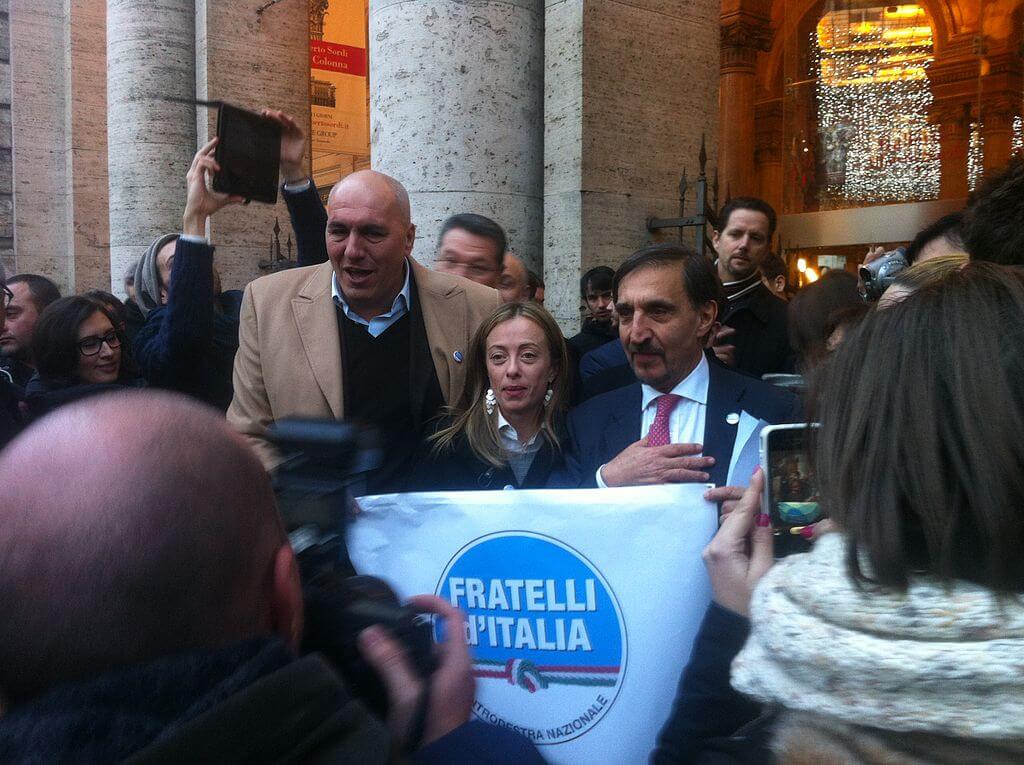
| Guido Crosetto, Giorgia Meloni and Ignazio La Russa at the press conference which announced the foundation of the Brothers of Italy in 2012. Source: Wikipedia. |
Besides being a hub for committed fascists, FdI has discernible ties to the Calabrian mafia. In December 2020, the independent TV program Report revealed that of all current Italian parties, Fratelli d’Italia had the highest number of representatives who were arrested for their affiliation with the mafia group ‘Ndrangheta.[42]
Although in the first years after its inception FdI was polling at under 5%, ever since 2019 the party has been steadily growing. In its early years, the party followed on the heels of Matteo Salvini’s Noi con Salvini/Lega Nord (We’re with Salvini/Northern League) party, which at the time had the political wind at its back, while also looking to the far-right fringe for support. For example, in the run-up to the 2015 presidential election, FdI sounded out its options regarding whom it would enter into a pre-election alliance with. Alongside Salvini, FdI first considered an alliance with the even more extreme CasaPound, arguably the most influential extra-parliamentary neofascist movement in Italy today, which from 2008 to 2019 operated as a political party.
In early 2015, a CasaPound offshoot called Sovranità (sovereignty) emerged, a far-right minority party that was supposed to represent CasaPound’s support for Salvini.[43] On February 28, 2015, Salvini organized a demonstration in Rome against then Prime Minister of Italy Matteo Renzi of the Democratic Party, in which about 30,000 people took part. Former CasaPound leader Simone di Stefano, along with Giorgia Meloni, were also among the speakers. Salvini and di Stefano’s involvement in Sovranità was cemented as late as May 2015 at Rome’s Brancaccio Theater.[44] However, in November 2015 another rally took place in Bologna, this time with the participation of Silvio Berlusconi and Giorgia Meloni. CasaPound, whose leadership was not invited, disliked Salvini’s “moderate” turn towards Berlusconi, and both parties confirmed that they would no longer cooperate. Ultimately, FdI entered an electoral alliance with Matteo Salvini’s Noi con Salvini/Lega Nord party and Berlusconi’s re-founded Forza Italia.[45] Currently, CasaPound supports the Eurosceptic party Italexit, founded in 2020, whose candidates include numerous CasaPound members.
In the meantime, FdI has managed to groom its own set of neofascist and neo-Nazi youth and student groups under the umbrella of its current youth organization, Gioventù Nazionale (GN, or national youth, 2014–present). They appear to be direct replicas of MSI and AN’s youth groups, further demonstrating how FdI has adopted the party structure of its predecessors. Gioventù Nazionale’s logo shows clear similarities with those of the youth groups that preceded it, which all sported a fist holding a tricolor flame: the MSI’s Giovane Italia (1954–1971); its successor Fronte della Gioventù (youth front, 1971–1996); Alleanza Nazionale’s Azione Giovani (1996–2009), and finally Il Popolo della Libertà’s Giovane Italia (2009–2014). Gioventù Nazionale’s logo shows a fist holding a tricolor flag instead of a tricolor flame. Nonetheless, the tricolor flame symbol lives on in FdI’s own logo.
Gioventù Nazionale is subdivided into Azione Studentesca (student action), for high school and university students between 14 and 25 years of age; and Azione Universitaria (university action), for university students between the ages of 18 and 32.[46] As mentioned above, both Azione Studentesca and Azione Universitaria have predecessors reaching back to the MSI, and were already known as such in Alleanza Nazionale times.
Azione Studentesca, which relaunched in 2016 under the leadership of Anthony La Mantia, is considered openly neofascist and much more radical than its predecessor.[47] As its precursors, Azione Studentesca’s logo sports the Celtic swastika variant first used by the French organization GRECE, then by MSI’s Fare Fronte, and finally adopted by Alleanza Nazionale’s Azione Studentesca. On its Facebook page, Azione Studentesca is praising far-right ideologues, such as Julius Evola, Ernst Jünger, Dominique Venner, Guillaume Faye, and Jean-François Thiriart, alongside notorious figures from the militant neofascist milieu, such as Pino Rauti.[48]
Azione Studentesca attaches great importance to the ideological and physical training of its cadre, which runs the gamut of fascist activism: fighting competitions and training of its members, nightly torch marches to commemorate fascist heroes and “martyrs,” disrupting left-wing events, or plastering city centers with posters in Azione Studentesca’s total advertising war.[49]
FdI’s International Connections
Overall, Fratelli d’Italia’s youth groups provide a framework for contacts with extra-parliamentary far-right and extremist groups from Italy and abroad. For example, there has been active collaboration between the Institut Iliade (a GRECE spinoff) and the ideological cadres of Fratelli d’Italia.[50] The Institut Iliade was founded in 2013 as the last wish of the far-right ideologue and GRECE co-founder Dominique Venner.[51] Some of the Institut Iliade’s publications were issued in Italian by the Azione Studentesca-affiliated publishing house Passaggio al Bosco (path through woods). The latter is run by Marco Scatarzi out of an Identitarian clubhouse in Florence called Casaggì Spazio Identitario, which doubles as Azione Studentesca’s city hangout.[52] On June 11, 2022, an event was held there, co-organized by Passaggio al Bosco and Iliade, which notably included the former president of GRECE, Claude Chollet, as a speaker.[53] The Casaggì clubhouse is plastered with paraphernalia of far-right youth and student movements, including Fare Fronte and Azione Studentesca, which is also linked on the clubhouse’s website.[54] Azione Studentesca, in turn, has advertised Passaggio al Bosco books and related events on its Facebook page.[55]
Overall, FdI has developed strong ties to like-minded leaders and parties across Europe and overseas. In September 2020, Meloni was elected chairwoman of the European Conservatives and Reformists Party (founded in 2009) in the European Parliament (with which her party, Fratelli d’Italia, is also part associated), co-chaired by Jorge Buxadé (Spain, Vox) and Radosław Fogiel (Poland, PiS party). Furthermore, Vicenzo Sofo is working with the group. He is the husband of the French far-right politician Marion Maréchal-Le Pen—the granddaughter of Jean-Marie Le Pen, founder of the French far-right party the Front National (National Front, now known as the Rassemblement National, or National Rally), and niece of the party’s current leader, Marine Le Pen. Sofo had been a member of the European Parliament for Salvini’s Lega party; however, in February 2021, he strongly disagreed with Salvini’s decision to join the Draghi government, and instead joined the Brothers of Italy and the European Conservatives and Reformists group. Besides, as an important liaison to the French far right, Sofo has been in touch with the Iliade Institute.[56]
As of 2022, Meloni has been a vocal supporter of the far-right Vox party in Spain, for which she gave a fiery speech in June.[57] Spain’s far right, which shares its Catholic roots with Italy and easily straddles the low language barrier between the two countries, is a natural ally for the FdI.
Furthermore, Meloni has developed extensive ties to the American right. In 2018, she was taken under the wing of then-US President Donald Trump’s former Chief White House Strategist Steve Bannon, who at the time was traveling Europe to rally allies for his Brussels-based far-right supergroup The Movement, all while he was building up an “Academy for the Judeo-Christian West” in an old Italian monastery, which he described metaphorically as a “gladiator school.”[58] That year, Meloni had invited Bannon to speak at the yearly Atreju rally, a far-right get-together organized by her since Alleanza Nazionale times, which has hosted the likes of French conservative party leader Marine Le Pen and Hungarian Prime Minister Viktor Orbán.[59]
In 2019, Meloni took part in the World Congress of Families (WCF) in Verona, Italy, alongside Matteo Salvini, at the time Deputy Prime Minister of Italy–a key hub of the international Christian right. She may have also been involved in the organization of the congress, since a picture of her exists together with WCF President Brian Brown a few months preceding the actual event, holding up the banner of the Verona congress.[60] Meloni has also been a guest at the National Prayer Breakfast in February 2020, an important get-together of the US religious right that reaches into the highest echelon of American and international politics.[61] Her election slogan, “God, family, fatherland,” naturally resonates with the Christian right across Europe and overseas, which has been cheering her success.
In early 2019, Meloni first appeared at the Conservative Political Action Conference (CPAC), held in Maryland, a notorious right-wing meeting, headlined by Donald Trump that year. There, she gave a fiery speech against the European Union, comparing the struggle of right-wing American federalists for more state sovereignty to those seeking to transform the European Union into a union of sovereign nations.[62] In February 2022, Meloni spoke for a second time at CPAC.[63] She started out her speech with the war of Russia against Ukraine, positioning herself clearly on the side of the latter. Ukraine’s President Volodymyr Zelenskiy has congratulated Meloni on her election victory, and in response she has reaffirmed her support.[64]
Her coalition partner Matteo Salvini and his Lega party have shown a particular closeness to Russia, with the party currently being under investigation as to whether it had received Russian funds. Silvio Berlusconi has also been sympathetic toward Russia, and is known as a personal friend of Putin. On the eve of the election, Berlusconi defended Putin, saying that the Russian leader simply wanted to replace Zelenskiy’s government with “decent people.”[65] Whether these conflicting positions may be an obstacle to finding post-election common ground between FdI and its coalition partners is uncertain. Russian gas deliveries to Italy stopped merely one week after the election, which has been deemed as Russia’s response to Meloni’s public backing of Ukraine, and which will certainly exert considerable economic pressure on the upcoming government.[66]
Experienced in power plays, Meloni is quite capable of changing her position and rhetoric according to the occasion. She excels in paying lip service to those who can increase her power, and in the current situation that is certainly the Atlanticist camp and a resurgent NATO. Her ability to switch from a fascistic to a more moderate register enables her to make herself palatable to power bases that are not necessarily far-right. For example, in February 2021, she became a member of the Aspen Institute, an influential non-partisan think tank based in Washington, DC, which includes many financiers, businessmen, and politicians.[67] Its roster of sustaining members includes representatives of oil companies, banks, insurers, and telecommunications and media companies—including, notably, Berlusconi’s RAI as well. Aspen’s Executive Committee includes two former prime ministers, two foreign ministers, and a former head of the Security and Information Department.[68]
***
Never in Italy’s postwar history has a neofascist party had as much support from the general population as Fratelli d’Italia, many of whose representatives not only look back favorably on Italy’s fascist past, but even to its most extreme exponents—from the Duce to Pino Rauti. In an effort to exorcise the party’s demons, FdI has been careful to separate parliamentary politics from its right-wing extremist underbelly. To that end, the party has largely outsourced its contacts with the extra-parliamentary far right to its youth and student groups, which engage in more hands-on action. That Meloni and her party have managed to make themselves palatable to large swaths of the population is bad enough. But what seems to be equally worrying is a tendency in Western democratic circles towards brushing past FdI’s fascist tendencies in light of the party’s staunch positioning behind Ukraine.
While Italy’s pro-Western alignment in the Ukraine war may serve the preeminent strategic goals of NATO countries, it should not come at the price of inviting fascists to the table, whose overall interests are more aligned with Russia’s than any Western European democratic common sense. Meloni’s ability to switch registers depending on her audience —from doe-eyed steward of Atlanticism to rapacious propagandist for a neofascist Italy—is both dangerous and treacherous. And despite her reassurances that she and her party are no menace to democracy, being at the helm of a majority coalition could lead to a neofascist resurgence in the country, particularly given the economic crisis that Italy is likely to face this winter.
[1] Valentin Rakovsky, “Italian Election Results,” Barron’s, September 26, 2022, https://www.barrons.com/news/italian-election-results-01664177107.
[2] Ten minority parties in the pre-electoral coalition of the center-right: Noi con l’Italia (NcI), led by Maurizio Lupi; Italia al Centro (IaC), led by Giovanni Toti; Identità e Azione (IdeA), led by Gaetano Quagliarello; Coraggio Italia (CI), led by Luigi Brugnaro; Unione di Centro (UdC), led by Lorenzo Cesa; Alleanza di Centro (AdC), led by Francesco Pionati; Nuovo Partito Socialista Italiano (NPSI), led by Stefano Caldoro;Partito Pensionati (PP), led by Carlo Fatuzzo; Partidu Sardu–Partito Sardo d’Azione (PSd’Az), led by Christian Solinas; andVerde è Popolare (VP), led by Gianfranco Rotondi. See: “Italy,” Europe Elects, accessed September 17, 2022, https://europeelects.eu/italy/.
[3] Angelo Amante, “Italy’s Meloni, Leading in Polls, Says She Is No Threat,” Reuters, August 10, 2022, https://www.reuters.com/world/europe/italys-meloni-leading-polls-says-she-is-no-threat-2022-08-10/.
[4] “Giorgia Meloni Nel 1996: ‘Mussolini è stato un buon politico, il migliore degli ultimi 50 anni,’ ” La Repubblica, August 16, 2022, https://web.archive.org/web/20220816164155/https://video.repubblica.it/politica/giorgia-meloni-nel-1996-mussolini-e-stato-un-buon-politico-il-migliore-degli-ultimi-50-anni/423107/424060?ref=RHTP-BS-I353012196-P7-S1-T1.
[5] “Giorgia Meloni ricorda Almirante: ‘Politico e patriota stimato anche dai suoi avversari’: Polemica sui social,” Open, May 22, 2020, https://www.open.online/2020/05/22/giorgia-meloni-ricorda-almirante-politico-e-patriota-stimato-anche-dai-suoi-avversari-polemica-sui-social/.
[6] Ronald D. Landa, “ ‘Shots from a Luce Cannon’: Combating Communism in Italy, 1953–1956,” National Security Archive, December 11, 2011, https://nsarchive.gwu.edu/document/22601-01-shots-luce-cannon-combating-communism.
[7] House Select Committee on Intelligence, Pike Committee Report Full, 1976, p. xiii, https://archive.org/details/PikeCommitteeReportFull/page/n11/mode/2up.
[8] Deborah Kisatsky, The United States and the European Right, 1945–1955 (Columbus: Ohio State University Press, 2005), 116.
[9] A stay-behind operation is a military/intelligence tactic whereby agents are secretly stationed in their own country who, in case of an enemy takeover, are to commit acts of sabotage, to form resistance movements, or act as spies.
[10] Tamir Sinai, “Eyes on Target: ‘Stay-Behind’ Forces during the Cold War,” War in History 28, no. 3 (July 2021): 681–700.
[11] “Commissione Parlamentare d’inchiesta sul Terrorismo in Italia e sulle Cause della Mancata Individuazione dei Responsabili delle Stragi,” Senato della Repubblica, April 14, 1992, https://www.senato.it/service/PDF/PDFServer/BGT/909972.pdf; Dario Azzellini, “Italy, Gladio 1970s–1980s,” in The International Encyclopedia of Revolution and Protest: 1500 to the Present, ed. Immanuel Ness (Wiley-Blackwell, 2010), https://www.researchgate.net/publication/338700813_Italy_Gladio_1970s-1980s.
[12] Sandra Bonsanti, “La banda dei ricatti e del tritolo,” La Repubblica, October 20, 1984, https://ricerca.repubblica.it/repubblica/archivio/repubblica/1984/10/20/la-banda-dei-ricatti-del-tritolo.html; Paola Di Caro, “P2, Berlusconi sconcerta gli alleati,” Corriere della Sera, March 8, 2000, https://web.archive.org/web/20151212001447/http://archiviostorico.corriere.it/2000/marzo/08/Berlusconi_sconcerta_gli_alleati_co_0_00030810231.shtml.
[13] Markus Sulzbacher, “Nazis, rote Gewerkschafter und CIA-Waffenlager: Ein unaufgeklärtes Kapitel Zeitgeschichte,” Der Standard, August 20, 2021, https://www.derstandard.de/story/2000128972497/nazis-rote-gewerkschafter-und-cia-waffenlager-ein-unaufgeklaertes-kapitel-zeitgeschichte.
[14] Kurt P. Tauber, “German Nationalists and European Union,” Political Science Quarterly 74, no. 4 (December 1959), 567 ff.; Jeffrey Bale, “The ‘Black’ Terrorist International: Neo-Fascist Paramilitary Networks and the ‘Strategy of Tension’ in Italy, 1968–1974” (PhD thesis, University of California at Berkeley, 1994), 90 ff.; Mike Cronin, The Failure of British Fascism: The Far Right and the Fight for Political Recognition (London: Palgrave Macmillan, 1996), 76 ff.
[15] Franco Ferraresi, Threats to Democracy: The Radical Right in Italy After the War (Princeton: Princeton University Press,1996), 59; “Inchiesta su stragi e depistaggi: Seguito dell’audizione del signor Stefano Delle Chiaie,” Commissione Parlamentare D’inchiesta sul Terrorismo in Italia e sulle Cause della Mancata Individuazione dei Responsabili delle Stragi, July 22, 1997, p. 1102, https://www.parlamento.it/service/PDF/PDFServer/DF/16063.pdf.
[16] Schutzstaffel (Protection Squadron: SS), Sicherheitsdienst (Security Service: SD).
[17] In 1949, Evola started contributing to two magazines which Rauti coedited: La Sfida and its successor Imperium, founded in January 1950. Imperium was suspended after only four issues due to the arrest of Rauti, the magazine’s co-editor Enzo Erra, and later Evola himself, in the context of a government investigation into the first postwar neofascist paramilitary organization, Fasci di Azione Rivoluzionaria (Fasces of Revolutionary Action), which led an armed struggle against the young Italian Republic. Based on the Imperium group, in November 1953 Rauti created Ordine Nuovo as an internal component of the MSI. See Nicola Rao, La fiamma e la celtica (Milan: Sperling & Kupfer Editori, 2006), 59.
[18] Originally published in Cantiere no. 3, March/April 1951; republished in Julius Evola, A Handbook for Right-Wing Youth (London: Arktos Media, 2017, electronic version).
[19] Philip Rees, Biographical Dictionary of the Extreme Right since 1890 (Hemel Hempstead: Harvester Wheatsheaf, 1990), 264.
[20] “Sara D’Agati, “The United States Information Agency and Italy during the Johnson Presidency” (PhD thesis, Cambridge, University of Cambridge, 2015), 108–109; Veronica Bortolussi, “I Rapporti Tra l’estrema Destra Italiana e l’Organisation de l’Armée Secrète Francese” (Master’s Thesis, Venice, Università Ca ’Foscari, 2017), 165; Philip Willan, “US ‘Supported Anti-Left Terror in Italy,’ ” The Guardian, June 24, 2000, https://www.theguardian.com/world/2000/jun/24/terrorism.
[21] Bale, “The ‘Black’ Terrorist International,” 141; Philip Willan, “Three Jailed for 1969 Milan Bomb,” Guardian, July 2, 2001, https://www.theguardian.com/world/2001/jul/02/philipwillan.
[22] Bale, “The ‘Black’ Terrorist International,” 143.
[23] Ferraresi, Threats to Democracy, 95. Fora detailed biography of Delle Chiaie in English, see Stuart Christie, Stefano Delle Chiaie: Portrait of a “Black” Terrorist, Black Papers, no. 1 (London: Anarchy Magazine, 1984), https://files.libcom.org/files/Stefano-Delle-Chiaie.pdf.
[24] Roger Eatwell, Fascism: A History (London: Pimlico, 2003), 259; Tobias Hof, “ ‘The Black Carlos’: The Story of Italian Right-Wing Terrorist Stefano Delle Chiaie (Part II: Stefano Delle Chiaie and the ‘Black’ International),” Centre for Analysis of the Radical Right, March 26, 2020, https://www.radicalrightanalysis.com/2020/03/26/the-black-carlos-the-story-of-italian-right-wing-terrorist-stefano-delle-chiaie-part-ii-stefano-delle-chiaie-and-the-black-international/.
[25] Caterina Froio et al., CasaPound Italia: Contemporary Extreme-Right Politics (London: Routledge, Taylor & Francis Group, 2020), 57.
[26] The name carries a double meaning. On its surface, it is an expression meaning to confront or face up to someone or something. However, in the context of militant politics, in which organizations sometimes include the military use of the term front in their names, it can also be read as “opening a front” on the political battlefield.
[27] “Fare Fronte,” Strage a Brescia (blog), accessed September 22, 2022, https://www.strageabrescia.it/portfolio/fare-fronte-2/.
[28] Meaning “European civilization research and study group,” the acronym spells out the French name for Greece: Grèce. Dominique Venner (1935–2013) volunteered in the Algerian War and then joined the clandestine far-right terrorist group Organisation de l’armée secrète (OAS) in the 1960s. Upon meeting his future protégé Alain de Benoist (b. 1943) in 1962, the two founded the ultra-right magazine and organization Europe-Action in 1963, and subsequently GRECE, both of which had ties to surviving Nazi and collaborationist networks. Venner and Benoist, who found common ground in their anti-Christian, anti-Semitic, and neopagan views, have become known proponents of the French New Right (Nouvelle Droite), a far-right current that dresses its racism in new terms, such as “ethnopluralism” or “archeo-futurism,” and particularly focuses on creating a far-right counterculture (under the guise of “metapolitics”).
[29] “Berlusconi rivendica il merito di aver portato al governo ‘fascisti e Lega’: Fratelli d’Italia replica: ‘Che tristezza,’ ” La Repubblica, September 28, 2019, https://www.repubblica.it/politica/2019/09/28/news/berlusconi_rivendica_il_merito_di_aver_portato_al_governo_fascisti_e_lega_fratelli_d_italia_replica_che_tristezza_-237191538/.
[30] Rapport 1998: Panorama des Actes Racistes et de l’Extremisme de Droite en Europe (Paris: Centre de Recherche d’Information et de Documentation Antiraciste, 1998), 127.
[31] US diplomatic cable on the genesis of the PdL: “Berlusconi’s Center-Right Shotgun Wedding,” March 27, 2009, WikiLeaks, https://web.archive.org/web/20220621234747/www.wikileaks.org/plusd/cables/09ROME356_a.html.
[32] “Italian PM Prodi Resigns after Foreign Policy Defeat,” CBC News, February 21, 2007, https://www.cbc.ca/news/world/italian-pm-prodi-resigns-after-foreign-policy-defeat-1.651945.
[33] Primo Di Nicola and Telesio Malaspina, “De Gregorio e la Cia: i verbali,” L’Espresso, March 7, 2013, https://espresso.repubblica.it/palazzo/2013/03/07/news/de-gregorio-e-la-cia-i-verbali-1.51609/.
[34] Ariel David, “‘Defend Our Christian Identity!’ Meet the Far Right ‘ Anti-Globalist’ Who Could Lead Italy,” Haaretz, June 3, 2019, https://www.haaretz.com/world-news/2019-06-03/ty-article-opinion/.premium/meet-italys-le-pen-the-defender-of-christian-identity-who-could-become-premier/0000017f-dbb3-d856-a37f-fff334e90000.
[35] Nello Trocchia, “Ad Affile va in scena la celebrazione del gerarca fascista: A spese nostre,” Il Fatto Quotidiano, August 12, 2012, http://www.ilfattoquotidiano.it/2012/08/12/ad-affile-va-in-scena-celebrazione-del-gerarca-fascista-a-spese-nostre/324248/; “Italy Memorial to Fascist Hero Graziani Sparks Row,” BBC News, August 15, 2012, https://www.bbc.com/news/world-europe-19267099.
[36] Ignazio La Russa contro Michele Emiliano: “Siamo tutti eredi del Duce, sei disperato ma non attacca,” “Sono erede dei partigiani” (La7, 2022), https://www.la7.it/laria-che-tira/video/ignazio-la-russa-contro-michele-emiliano-siamo-tutti-eredi-del-duce-sei-disperato-ma-non-attacca-15-09-2022-451730.
[37] David, “ ‘Defend Our Christian Identity!’ ”
[38] “Holiday with Mussolini: Dictator’s Granddaughter Turns Tour Guide for Italian Fascism,” New Zealand Herald, September 27, 2018, https://www.nzherald.co.nz/travel/dictators-granddaughter-rachele-mussolini-turns-tour-guide-for-italian-fascism/ZWVMYPNHDNJMMKFZ5KHER46E7U/.
[39] Alfonso Venturini, “Mussolini, Vittorio,” in Dizionario Biografico degli Italiani, 2012, https://www.treccani.it/enciclopedia/vittorio-mussolini_(Dizionario-Biografico).
[40] Alessandra Longo, “Campo Hobbit Trent’anni Dopo: ‘Quando Eravamo Topi Di Fogna,’ ” la Repubblica, June 8, 2007, https://ricerca.repubblica.it/repubblica/archivio/repubblica/2007/06/08/campo-hobbit-trent-anni-dopo-quando-eravamo.html.
[41] Picture on Isabella Rauti’s personal Facebook page, accessed October 23, 2022, https://www.facebook.com/photo.php?fbid=10220183570329505&set=t.100002283794599&type=3; Centro Studi Pino Rauti, http://pinorauti.org; Isabella Rauti’s personal Facebook page, accessed October 2, 2022, https://www.facebook.com/IsabellaRauti.PaginaPersonale.
[42] Giorgio Mottola, with Andrea Palladino and Norma Ferrara, “Cinque sfumature di nero,” Report (RAI, July 12, 2020), https://www.rai.it/programmi/report/inchieste/Cinque-sfumature-di-nero-90c05575-d87c-487a-ae75-fff02272cc9b.html.
[43] Marzio Brusini, “Sovranità: l’associazione politico culturale di Casa Pound che appoggia Matteo Salvini,” HuffPost Italia, January 13, 2015, https://www.huffingtonpost.it/2015/01/13/sovranita-casa-pound-matteo-salvini_n_6462966.html; “Salvini Day, nel mondo della destra spunta una nuova sigla: Sovranità,” Corriere della Sera, February 28, 2015, http://roma.corriere.it/notizie/cronaca/15_febbraio_28/salvini-day-mondo-destra-spunta-nuova-sigla-sovranita-8fe0d81c-bf5e-11e4-911e-3d01b106f698.shtml.
[44] Luca Sappino, “Ora Matteo Salvini è il Leader di CasaPound,” Espresso, July 3, 2015, https://web.archive.org/web/20150703181718/https://espresso.repubblica.it/palazzo/2015/05/12/news/ora-matteo-salvini-e-il-leader-di-casapound-1.211901.
[45] The first iteration of Forza Italia existed from 1994 to 2009, when it merged with Berlusconi’s catch-all party Il Popolo della Libertà. After PdL’s dissolution in 2013, Berlusconi re-founded Forza Italia, which still exists today.
[46] “Regolamento adesioni,” Gioventù Nazionale, accessed September 23, 2022, http://www.gioventunazionale.it/regolamento-adesioni/; “Statuto Gioventù Nazionale,” Gioventù Nazionale, August 2020, http://www.gioventunazionale.it/wp-content/uploads/2020/08/STATUTO.pdf.
[47] Christian Raimo, “Ritratto del neofascista da giovane,” Internazionale, January 29, 2018, https://www.internazionale.it/reportage/christian-raimo/2018/01/29/neofascismo-scuola-ragazzi; Christian Raimo, Ho 16 anni e sono fascista: indagine sui ragazzi e l’estrema destra (Milan: Piemme, 2018), EPUB, https://www.google.de/books/edition/_/I3ZODwAAQBAJ.
[48] Photos posted by Azione Studentesca on Facebook, accessed September 24, 2022, https://www.facebook.com/azionestudentescaitalia/photos. The German writer Ernst Jünger (1895–1998) was a trailblazer for Nazism who came to have a lasting influence on the postwar German far right. Guillaume Faye (1949–2019) was a leading proponent of the French New Right, whose racist ideology included the concept of “archeo-futurism,” widely adopted by the French far right. The Belgian Jean-François Thiriart (1922–1992) was a Waffen-SS member who in the 1960s founded the pan-European Nazi-revivalist organization Jeune Europe [young Europe], whose Italian branch notably included the far-right figureheads Claudio Mutti and Mario Borghezio.
[49] Facebook post by Azione Studentesca, September 16, 2020, https://www.facebook.com/azionestudentescaitalia/photos/a.1787452568191601/2747345848868930/.
[50] Jean-Yves Camus, “The French New Right 52 Years on: Alive and Kicking as Ever,” Centre for Analysis of the Radical Right, April 30, 2020, https://www.radicalrightanalysis.com/2020/04/30/the-french-new-right-52-years-on-alive-and-kicking-as-ever/.
[51] Adriano Scianca, “L’Institut Iliade arriva in Italia: Chollet: ‘Costruiamo insieme la nostra Europa,’ ” Il Primato Nazionale (blog), June 9, 2022, https://www.ilprimatonazionale.it/cultura/linstitut-iliade-arriva-in-italia-chollet-costruiamo-insieme-la-nostra-europa-235836/.
[52] Although the address of Passaggio al Bosco is not mentioned on the publisher’s website, the latter does list the former’s tax ID number (IVA 06714400485) and instructs that payments are to be made out to an account of one Marco Scatarzi. See “Termini e Condizioni,” Passaggio al Bosco, accessed October 20, 2022, https://www.passaggioalbosco.it/termini_e_condizioni/. In an Italian business registry, this tax ID is confirmed as belonging to Marco Scatarzi, while the address is specified as Via Frusa 37, Florence, which matches the address of the Casaggì Spazio Identitario. See “Dati della società–Scatarzi Marco,” Ufficio Camerale, accessed September 22, 2022, https://www.ufficiocamerale.it/5635/scatarzi-marco; “Contattaci,” Casaggì Firenze–Destra Identitaria (blog), accessed September 22, 2022, http://casaggi.blogspot.com/p/contattaci_4.html.
[53] Scianca, “L’Institut Iliade arriva in Italia”; Azione Studentesca Facebook post, June 12, 2022, https://www.facebook.com/azionestudentescaitalia/posts/pfbid0az3nn7HrEp1panFi87UJD5uPdsvGntjEHvsSEopaLDQpS8FGbmnjfMPRza9C5Dtjl.
[54] Casaggì Firenze–Destra Identitaria (blog), accessed September 22, 2022, http://casaggi.blogspot.com/.
[55] Facebook post by Azione Studentesca, February 16, 2022, https://www.facebook.com/azionestudentescaitalia/posts/pfbid02WCmoNiqDz6zg66aFadrEbiaF52u4Z8QxnP7wU8RQEw994v68jARczqyeTRMhn2ysl; Facebook post by Azione Studentesca, May 3, 2022, https://www.facebook.com/azionestudentescaitalia/posts/pfbid0337gBkPbUhxN4ApW3WtY9XSSdjpZBgGGdcwXKn2nQDRq89hHhRbmgioxrDPhSQ1Dnl.
[56] “ ‘Europe: l’heure des frontières’: l’Institut Iliade annonce son colloque pour le 6 avril 2019,” Breizh-Info, January 30, 2019, https://www.breizh-info.com/2019/01/30/110875/europe-lheure-des-frontieres-linstitut-iliade-annonce-son-colloque-pour-le-6-avril-2019/.
[57] “Meloni in Andalusia per Sostenere Vox, Dal Palco Arringa La Folla in Spagnolo,” Corriere della Sera YouTube channel, June 13, 2022, https://www.youtube.com/watch?v=jMad7nLO3OM.
[58] John Haltiwanger, “Steve Bannon’s Right-Wing ‘Gladiator School’ Booted from Italian Monastery,” Business Insider, September 8, 2021, https://www.businessinsider.com/steve-bannon-right-wing-gladiator-school-booted-from-italian-monastery-2021-9.
[59] Barbie Latza Nadeau, “Inside Steve Bannon’s Alt-Right Circus: A Trip to Rome to Rally Like-Minded Thinkers,” The Daily Beast, September 23, 2018, https://www.thedailybeast.com/inside-steve-bannons-alt-right-circus-a-trip-to-rome-to-rally-like-minded-thinkers; Paolo Foschi, “Orban ad Atreju: Governo, in Italia Separato dal Suo Popolo,” Corriere della Sera, September 19, 2021, https://www.corriere.it/politica/19_settembre_21/orban-ad-atreju-si-rimpatrio-migranti-maio-eviti-ingerenze-69056bc2-dc82-11e9-95a3-10409ad8b828.shtml.
[60] Giorgia Meloni, Facebook post, December 10, 2018, https://www.facebook.com/giorgiameloni.paginaufficiale/photos/a.10151958645677645/10156778550147645/.
[61] Valerio Berra, “Da Io sono Giorgia all’Aspen Institute: l’irresistibile ascesa di Meloni tra popolo, canzonette e fascino dei poteri forti,” Open, February 3, 2021, https://www.open.online/2021/02/03/giorgia-meloni-aspen-institute/.
[62] “Intervento Integrale di Giorgia Meloni in Inglese al CPAC a Washington, 2019,” Fratelli d’Italia YouTube channel, March 2, 2019, https://www.youtube.com/watch?v=BwqKQ6NRsEQ.
[63] “President Giorgia Meloni Speech at CPAC 2022,” ECR Party YouTube channel, February 26, 2022, https://www.youtube.com/watch?v=ajBhHJ2YXjU.
[64] “Meloni to Zelenskyy: Ukraine Can Count on Italys [sic] Support,” Ukrainska Pravda/Yahoo! News, September 28, 2022, https://news.yahoo.com/meloni-zelenskyy-ukraine-count-italys-073327029.html.
[65] Nick Squires, “Putin Wanted to Replace Zelensky with a Government of Decent People, Says Silvio Berlusconi,” Telegraph, September 23, 2022, https://www.telegraph.co.uk/world-news/2022/09/23/putin-wanted-replace-zelensky-government-decent-people-says/.
[66] Melissa Eddy, “Gazprom Halts Gas Supplies to Italy,” New York Times, October 1, 2022, https://www.nytimes.com/2022/10/02/world/europe/gazprom-halts-gas-supplies-to-italy.html.
[67] Berra, “Da Io sono Giorgia all’Aspen Institute.”
[68] “Executive Committee,” Aspen Institute Italia, accessed September 18, 2022, https://www.aspeninstitute.it/en/institute/aspen-community/executive-committee.







